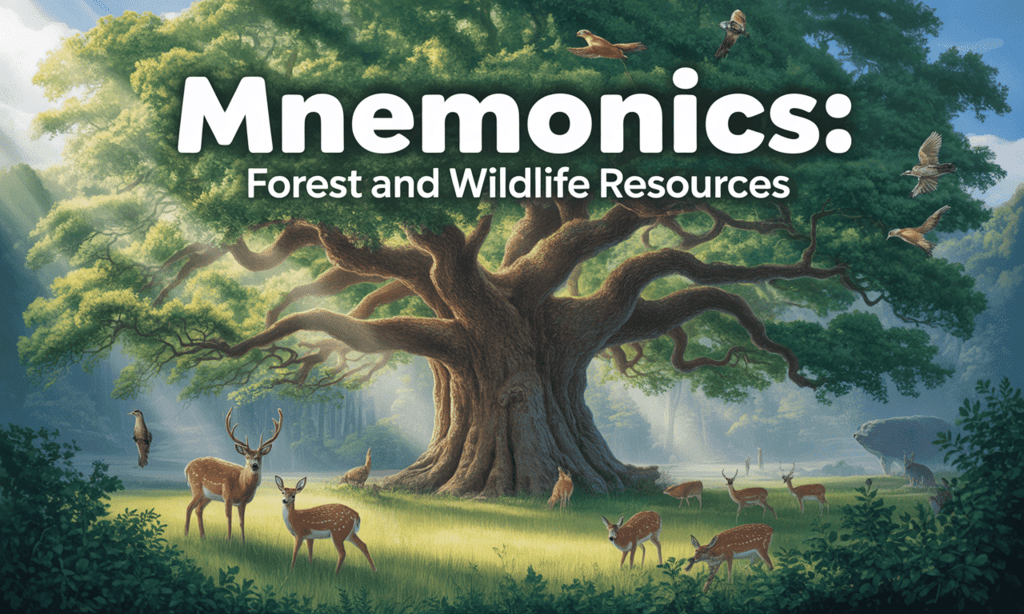Mnemonics: Forest and Wildlife Resources | Social Studies (SST) Class 10 PDF Download

1. Introduction to Biodiversity
Mnemonic: "LIFE-WEB"
Interpretations:
L: Life forms from microbes to whales
I: Interconnected ecosystems
F: Forests are crucial producers
E: Ecosystem supports human life
W: Water, air, and soil depend on biotic elements
E: Every organism plays a role
B: Biodiversity is essential for balance
Explanation: Life on Earth includes everything from microorganisms to massive animals. All organisms are linked in a web of life that supports the environment and us. Forests act as producers, maintaining the quality of air, water, and soil, all of which are crucial for our survival.
2. Flora and Fauna in India
Mnemonic: "INDIA-WILD"
Interpretations:
I: India is among top biodiverse nations
N: Nearly 8% of global species
D: Decline of species (10% flora, 20% mammals endangered)
I: Iconic species critically endangered
A: All types—from wild to cultivated
W: Wide variety of forms and functions
I: Interdependent ecosystems
L: Loss of species is alarming
D: Diversity makes ecosystems resilient
Explanation: India hosts a vast range of flora and fauna, contributing 8% of global biodiversity. However, several species face extinction. Biodiversity ensures ecological interdependence, balance, and resilience.
3. Conservation of Forests and Wildlife
Mnemonic: "SAVE-NATURE"
Interpretations:
S: Safeguard ecosystems
A: Act (1972 Wildlife Protection Act)
V: Various species protected
E: Endangered species laws
N: National projects launched (Tiger, Rhino, etc.)
A: Amendments include insects and plants
T: Trade restrictions on wildlife
U: Unique habitats preserved
R: Rare species recovery
E: Elephant, Blackbuck, Snow Leopard protected
Explanation: India has adopted strong legal and practical steps for conservation, such as the 1972 Wildlife Act, various animal-specific projects, and extending protection to plants and insects.
4. Project Tiger
Mnemonic: "TIGER-ALERT"
Interpretations:
T: Tiger count dropped drastically (55,000 → 1,827)
I: Illegal poaching and trade
G: Growing human interference
E: Endangered species status
R: Reserves established
A: Asian medicine trade threat
L: Launched in 1973
E: Ecological role of tigers
R: Reserves in major national parks
T: Tigers are ecosystem protectors
Explanation: Project Tiger, launched in 1973, aimed to reverse the drastic decline in tiger population due to poaching, habitat loss, and human activities. Tigers are crucial for ecological balance, and many tiger reserves now exist in India.
5. Types and Distribution of Forests in India
Mnemonic: "FPU-TRACK"
Interpretations:
F: Forest types – Reserved, Protected, Unclassed
P: Protected forests – 1/3rd of total area
U: Unclassed forests – community/government owned
T: Top state – Madhya Pradesh (75% permanent forests)
R: Reserved forests – most valuable
A: Andhra, Tamil Nadu, Kerala – also rich in reserves
C: Community-managed – common in NE states, Gujarat
K: Key roles – conservation, biodiversity, resources
Explanation: Indian forests are categorized as Reserved, Protected, and Unclassed. Ownership and management differ by state, with significant community participation in the Northeast and Gujarat.
6. Community and Conservation
Mnemonic: "PEOPLE-GREEN"
Interpretations:
P: People participate in conservation
E: Efforts like Chipko movement
O: Opposition to harmful development (e.g., mining)
P: Protection by villagers (Sonchuri model)
L: Local rules against hunting
E: Ecological farming by Beej Bachao & Navdanya
G: Government + community (JFM)
R: Revival of degraded forests
E: Eco-based livelihoods
E: Empowerment through forest rights
N: Nature respected by traditional beliefs
Explanation: Community-led efforts like the Chipko movement, Joint Forest Management (JFM), and eco-farming are strengthening conservation. Traditional knowledge and cultural values help preserve biodiversity and forest ecosystems.
|
66 videos|614 docs|79 tests
|
FAQs on Mnemonics: Forest and Wildlife Resources - Social Studies (SST) Class 10
| 1. What are the key components of forest ecosystems? |  |
| 2. Why are forests important for wildlife conservation? |  |
| 3. What are the main threats to forest and wildlife resources? |  |
| 4. How can we promote sustainable forest management? |  |
| 5. What role do national parks play in wildlife conservation? |  |
















